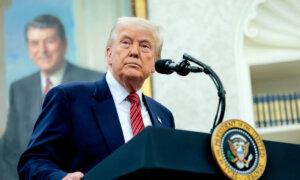President Donald Trump’s tariffs were so well-advertised that their initial effect was the opposite of what was intended. Beginning in the fourth quarter of 2024, U.S. importers tried to get ahead of the tariffs, ordering heavily in China to secure an inexpensive inventory before costs rose with the tariffs. Imports of China-made goods surged.
Now that the tariffs are in place, orders have fallen off precipitously, because buyers already hold huge inventories from that earlier buying, because costs are now higher, and because hopes for future tariff reductions have prompted U.S. buyers to wait as long as they can to avoid buying at today’s high levies. Although official statistics on this most recent period have yet to emerge, the shipping news tells the story.
From November 2024 through March, imports from China had a wild ride. No one knew where all the tariffs would land or how high the White House would set them, but everyone knew that they would raise future costs, especially in China, a special target of Trump’s efforts.
Although official import-export figures for this most recent period are not yet available, shipping information and commentary tell the tale of these cutbacks. The Port of Long Beach, California, where many Chinese products enter the United States, reports a 30 percent drop in container arrivals in just the past few weeks. Large container operators have confirmed the 30 percent figure in their accounting of eastbound transpacific shipments.
Although few such operators have cut scheduled shipping as yet, many have announced that they are using smaller vessels. Smaller operators have already cut back on voyages, canceling some 24 from China to the U.S. West Coast in just the opening days of May. Bookings from Southeast Asia have picked up, largely from Chinese-owned operations in these other countries, but these hardly make up the slack left by reductions in direct China shipments.
In yet another sign of tariff pressure, Chinese e-commerce platforms have seen increased activity. These operators send Chinese products directly to buyers in the United States and elsewhere, and by keeping each shipment small, they can get around the new tariffs that their larger commercial competition must pay.
Shipments under $800, for instance, pay a tariff of 120 percent or a $100 flat fee on each item. That is a steep charge compared with earlier years, but still less than the 145 percent on larger shipments. The tariff on small shipments is scheduled to rise after June 1, but that increase has been paused. For now, it is an attractive alternative, and these platforms have accordingly seen increased business. They have even developed apps to break up shipments into smaller amounts so that buyer and seller can still secure the so-called small-package exemption.
For now, such subterfuges and the heavy inventory built up earlier can tide over U.S. buyers of Chinese products. Time, however, is running out for such strategies. For U.S. retailers to meet the back-to-school and holiday shopping seasons, importers will have to order by June to get passage for their goods during the seasonally busy summer shipping season. They can hope that negotiations between Washington and Beijing can bring down tariffs quickly, or they must find sources outside China. And they must act fast. Either way, China’s economy is facing a day of reckoning.







